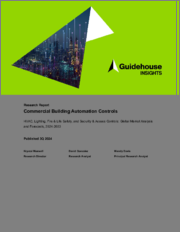
|
시장보고서
상품코드
1511766
상업용 빌딩 자동화 제어 - HVAC, 조명, 화재 및 인명구조, 보안 및 출입통제 : 세계 시장 분석 및 예측(2024-2033년)Commercial Building Automation Controls - HVAC, Lighting, Fire & Life Safety, and Security & Access Controls: Global Market Analysis and Forecasts, 2024-2033 |
||||||
기업들이 에너지 소비와 탄소 배출량을 줄이려는 노력으로 지난 10년간 상업용 빌딩 자동화 제어에 대한 수요가 증가하고 있으며, 빌딩 소유주와 시설 관리자들은 HVAC, 조명, 소방, 보안, 출입 통제 등의 기술을 자동화함으로써 에너지 소비 효율, 비상 대응 시간 단축, 건강하고 쾌적한 주거 환경 등의 이점을 누리고 있습니다. 에너지 소비 효율화, 긴급 상황 대응 시간 단축, 보다 건강한 주거 환경 구현 등의 이점을 얻을 수 있다는 것을 깨닫고 있습니다. 최신 빌딩 기술의 발전은 모든 빌딩 시스템을 하나의 인터페이스를 통해 연결하고 관리할 수 있는 능력을 촉진하여 실시간 통신을 가능하게 하고, 빌딩 환경 변화에 대한 대응을 자동화하고 있습니다.
에너지 가격 변동, 지속가능성에 대한 이해관계자의 압력, 법적 의무, 공간 활용 최적화의 필요성 등의 요인으로 인해 최근 몇 년동안 전 세계 다양한 기업과 조직이 스마트 통합 시스템으로의 전환이 가속화되고 있습니다. 또한, 상업용 빌딩 자동화 기술 공급업체들은 타사 빌딩 관리 시스템에 원활하게 통합할 수 있는 개방형 통신 프로토콜과 결합된 스마트 시스템을 개발하여 자동화 기술을 보다 쉽고 빠르게 배포할 수 있게 되었습니다. 고객 수요 증가와 더 쉽게 통합할 수 있는 기술의 결합으로 상업용 빌딩 자동화 제어 시장 규모가 확대되고 있습니다.
본 보고서는 세계의 상업용 빌딩 자동화 제어 시장을 종합적으로 분석했으며, 최근 시장의 주요 동향과 촉진-억제요인, 향후 10년간 시장 동향 전망, 지역별(북미, 유럽, 아시아태평양, 라틴아메리카, 중동 및 아프리카), 기술별(HVAC 제어, 조명제어, 소방/인명구조 제어, 보안/접근제어), 건축물유형별(사무실, 소매점, 교육시설, 의료시설, 호텔/레스토랑, 공공기관/회의장, 창고, 교통수단) 상세 동향 등의 정보를 전해드립니다.
목차
제1장 주요 요약
제2장 시장 문제
- 시장 동향
- 성장 촉진요인
- 성장 억제요인
- 가격
제3장 산업 밸류체인
- 밸류체인
- 경쟁 구도
- 기업 인수합병(M&A) 활동
- 비즈니스 모델의 진화
제4장 시장 예측
- 예측 범위
- 예측 부문
- 예측 방법
- 세계 시장 개요
- 기술 부문
- 건물 유형
- 지역별 예측
- 북미
- 유럽
- 아시아태평양
- 라틴아메리카
- 중동 및 아프리카
제5장 결론 및 제안
- 3대 포인트
- 추천 사항
- 빌딩 제어 기기 제조업체
- 에너지 효율 추진자와 정책 입안자
제6장 두자어 및 약어 리스트
제7장 목차
제8장 도표
제9장 조사 범위
제10장 정보원, 조사 방법, 주석
LSH 24.07.23The demand for commercial building automation controls has been growing over the past decade as organizations aim to reduce their energy consumption and carbon footprint. By automating technologies such as HVAC, lighting, fire and life safety, and security and access controls, building owners and facility managers have realized they can achieve benefits such as more efficient energy consumption, increased response times to emergencies, and a healthier occupant environment. The latest advances in building technologies have facilitated the ability to connect and manage all building systems through a single interface that enables real-time communication and automates responses to changes in the building environment.
The transition by organizations worldwide toward smart, integrated systems has accelerated in recent years due to factors such as energy price volatility, sustainability stakeholder pressures, legislative obligations, and the need to optimize space utilization. In addition, commercial building automation technology vendors have been able to develop smart systems paired with open communications protocols that can seamlessly integrate into third-party building management systems and allow for easier and faster deployment of automated technologies. The combination of increased customer demand with more easily integrated technologies has resulted in a growing market size for commercial building automation controls.
This Guidehouse Insights report provides a comprehensive analysis of the commercial building automation controls market, covering the trends, drivers, and barriers that have shaped its evolution in recent years. Additionally, it presents a 10-year forecast, offering insights into the future trajectory of the market across five global regions (North America, Europe, Asia Pacific, Latin America, Middle East & Africa), four technology segments (HVAC controls, lighting controls, fire and life safety controls, security and access controls), and eight commercial building types (office, retail, education, healthcare, hotels and restaurants, institutional/assembly, warehouse, transport).
Table of Contents
1. Executive Summary
- 1.1 Market Overview
- 1.2 Market Drivers
- 1.3 Market Barriers
- 1.4 Market Forecast
2. Market Issues
- 2.1 Market Trends
- 2.1.1 Evolving Occupant Expectations for Smart Buildings
- 2.1.2 Complexity of Integrating into Existing Sensors
- 2.1.3 Shortage of Skilled Labor in Facility Management
- 2.1.4 SEC Climate Disclosure Proposal
- 2.1.5 Corporate Sustainability Reporting Directive
- 2.2 Drivers
- 2.2.1 Legislative Obligations and Building Codes
- 2.2.2 Resilience to Energy Price Volatility
- 2.2.3 Occupant Health and Well-Being
- 2.2.4 Incentives and Rebates from Utilities
- 2.2.5 Wider Adoption of Performance Contracts
- 2.3 Barriers
- 2.3.1 High Costs
- 2.3.2 Supply Chain Issues
- 2.3.3 Slowdown of New Construction
- 2.3.4 Complexity of New Systems
- 2.3.5 Cybersecurity Concerns
- 2.4 Pricing
3. Industry Value Chain
- 3.1 Value Chain
- 3.2 Competitive Landscape
- 3.2.1 M&A Activities
- 3.2.2 Business Model Evolution
4. Market Forecasts
- 4.1 Forecast Scope
- 4.2 Forecast Segments
- 4.3 Forecast Methodology
- 4.4 Global Overview
- 4.4.1 Technology Segments
- 4.4.2 Building Types
- 4.5 Regional Forecasts
- 4.5.1 North America
- 4.5.2 Europe
- 4.5.3 Asia Pacific
- 4.5.4 Latin America
- 4.5.5 Middle East & Africa
5. Conclusions and Recommendations
- 5.1 Three Big Takeaways
- 5.2 Recommendations
- 5.2.1 Building Controls Manufacturers
- 5.2.2 Energy Efficiency Advocates and Policymakers



















